|
Word Gems
exploring self-realization, sacred personhood, and full humanity
Editor's 1-Minute Essay: Part III
Beauty is the child of Truth and Goodness
|
What we judge as Beautiful reveals our state of being in terms of current perceptions of Truth and Goodness.
|
return to "Beauty" main-page
"Beauty is the translucence, through material phenomena, of the eternal splendor of the One.” Plotinus

|
Editor's prefatory comments:
I am greatly indebted to Dr. Mortimer Adler for what I know about this subject; which isn’t much, as we’ll be investigating these concepts for a very long time to come.
In the “Writing” article we discussed how the typical story plot of our world will soon become passé. Look at virtually any DVD jacket. See the movie synopsis. It goes something like this:
“Mary and/or John Smith were having a wonderful life until a day came when, without warning, their world blew up. Threats and disaster suddenly mounted on every side. They now valiantly fights back against incredible odds to save themselves and those they love. Will they succeed? Be prepared for danger, action, drama, love, humor, and thrill-a-minute.”
Well, to one degree or another, that’s pretty much the size of it, isn’t it, for all “stories.” In fact, a “story” isn't even considered to be such without this element of problem-cause-solution, some threat to well-being. All this appeals to the "Needy Little Me" Ego. But we are headed for a new world, Summerland, wherein there are no invasions, no threats, no upheavals, no loss of happiness. And therefore the very concept of what constitutes a “story,” or meaningful literature, or even the nature of the arts, will change for us.
In that coming day of better sightedness, we will still be interested in literature and the arts, but not in a low-grade, base-passion, scare-me-to-death way. Instead, we will seek out artists, seers, and teachers who can answer questions such as,
“Who can tell me how to access greater joy in my life and spirit? Who can show me the way to better perceptions of love and peace? Who can tell me more about truth, goodness, and beauty?”
This “Part III essay on Beauty” offers a small down-payment on that coming attraction. I write this primarily for my own edification, to clarify my own thinking, but you can read my notes if you'd like.
The following is a redistillation of some of Dr. Adler's writings -- discussions from his Syntopicon essay, his book Six Great Ideas, and his 1950s tv-episode on The Great Idea of Beauty -- plus, at no extra charge, my own developing insights.
|
a triad which judges all things
Truth, Goodness, and Beauty form a tribunal by which we judge our lives, the world, and its accoutrements.
These three great ideas have been called “transcendental” in that all things fall under their winnowing eye, determining for us what is true or false, good or evil, beautiful or unpleasing.
Truth, Goodness, and Beauty, it might be assumed, stand as three independent judges, equally exercising an authority of evaluation. But this is incorrect.
Beauty, the offspring of Truth and Goodness
Truth and Goodness, to a certain extent, share common ground and lead us to Beauty, which, as their child, reflects aspects of the parents.
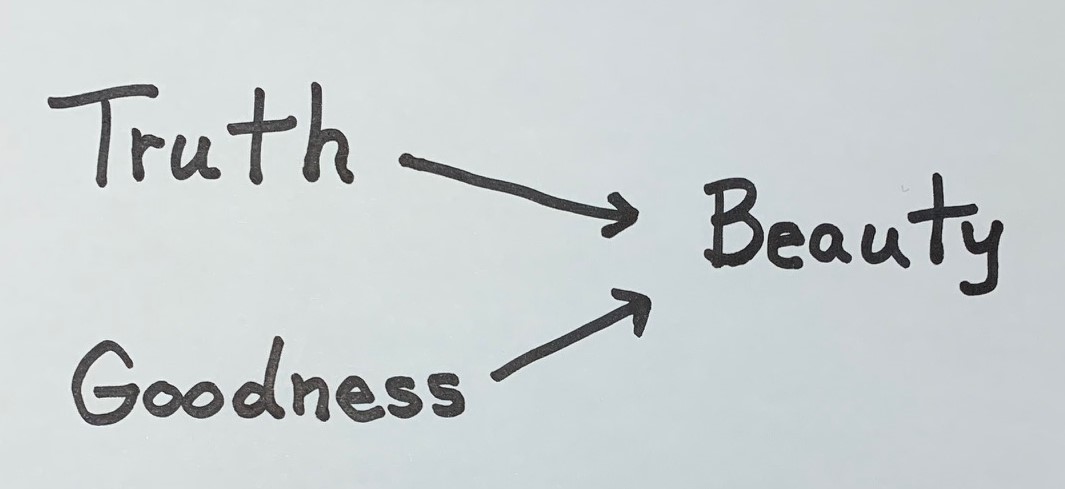
Is Beauty a problem-child?
Beauty is a problem-child, but only because its unsoundness was transmitted from its parents, Truth and Goodness. Let's see what this means.
Does Beauty exist only in the eye of the beholder?
Editor’s note: This dictum always makes me smile as I’m reminded of an alternate version by my ancient college friend, Grahame: “Beauty is in the eye of the beer-holder.” That’s funny, but it can also be pretty accurate. We’ll talk about this.
There is an ancient Latin phrase, translated as, “There’s no use arguing over matters of personal taste.” Is Beauty just a private opinion, with some agreeing and some objecting? Well, we have to say, on a certain level, this is true – but how far do we take this general principle?
Before we answer this, let’s acknowledge that this entire area of relativistic thinking has extended to, or maybe derived from, the parents, Truth and Goodness:
You say something is true. I say it’s false or error. You say, “My truth is not your truth, and no one has the right to tell me what to do or believe.”
You say something is good. I say it’s bad. You say, “I like it, I want it, and for me it’s good, and no one has the right to tell me what I should like or want.”
|
Much of what needs to be understood about Truth and Goodness has already been offered in various articles on the Word Gems site and cannot be reproduced here. We should also acknowledge that it would be very beneficial to study Dr. Adler’s writings on these subjects: his Syntopicon essays and his book “Six Great Ideas.” However, to offer a summary of Truth and Goodness:
The essence of Truth
Truth is not so difficult to define. Truth, in our thinking, is a one-to-one correspondence between the thoughts in our head and reality as it exists.
Our personal opinions never enter into the equation concerning truth. What we believe, shout about, have fits over, will not change what is.
The statement “This is my truth, even if it’s not your truth” offers more heat than light. The facts of the world, life as it is, reality unvarnished, will not be affected by our small opinions, one way or the other. If millions of people say, “The Earth is flat, and this is my truth, because I read it in the Bible” or “heard it at church from my Infallible Guru,” the spherical reality of our world will not suffer a whit.
To take the extreme relativistic stance that “This is true for me, even if it’s not true for you” confuses mere opinion with hard-edged reality. Our judgments about what exists, if they’re wrong – that is, if there is no one-to-one correspondence between mind and the facts of the world – will have not the slightest bearing upon Truth as it is. People believe all sorts of things, most of it errant, but none of this mental chaos affects what’s real to even the smallest degree.
The essence of Goodness
When people say, “This is true for me,” what they’re really saying is, “I like it, I want it.” In this declaration, Truth now enters the realm of the Good and becomes a form of the Good. To say something is “good” speaks to one’s desires. What we label as “good” is to view it as an object of desire.
Relativists say there is nothing good or evil in itself but that thinking makes it so. In other words, “If I want it, if I desire it, then, for me, it’s good.”
Look at how this principle of private definition of the Good has played out in history and in our world today.
|
We have not lost sight of our main topic Beauty but must take the long road home here to define terms which are closely related to Beauty.
I wrote the following inset-box for the "morality" page to feature an insight of Herodotus, but it fits very well with our present discussion of definitions of Goodness:
|
cherished notions of “motherhood and apple-pie” vary from culture to culture
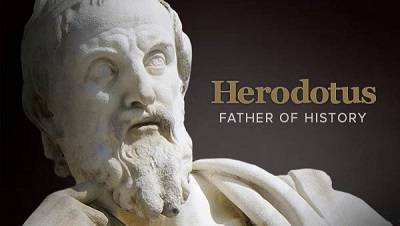
Herodotus (writing circa 450 BC), in his treatise on the Greco-Persian wars, comments on “nomos,” the Greek word for “custom, convention, or law.”
He talks about the arbitrariness of “nomos,” of how people become accustomed to what they know and what they’re taught in a particular culture, religion, or society.
barbarity to one, the good life to another
In Greece, Herodotus says, a certain activity “X” is considered a barbarity, something, according to his sensibilities, beyond the pale of what any person of even modicum advancement would tolerate. But, he asserts, in another society of the Near East, “X” is considered a normative expression of “nomos,” indeed, a reasonable, even honored, course of action, with the refusal of “X” deemed to be an atrocity and appallingly distasteful.
who wrote the html-code for your programming, what you believe
The great “father of history,” Herodotus, is correct, of course. That which the average person believes is simply a product of what Grandma said, the Nice Young Man at Church said, what teacher in third grade said. These early pedagogues “wrote the html code,” our cultural programming, for what would become our personal sense of propriety, of right and wrong. In popular parlance, we refer to this burdening weight of prejudicial assumption as our “baggage,” which is not easy to set aside.
you can be conditioned to believe anything
Krishnamurti's lecture, Brockwood Park, England, Sept 14, 1969
"You know, there is a whole section, the Communists, who do not believe in spirit, not in a spirit, nor in a soul. The whole Asiatic world believes that there is a soul, that there is the Atman. You can be conditioned to believe anything. The Communist doesn't believe in God; the others believe in God because that is the way they have been brought up. The Hindus believe in a thousand different gods, conditioned by their own fears, their own demands and their own urges. Can one become aware of these conditionings - not only of the superficial conditionings but also of those deep down - and be free of them? If one is not free, one is a slave, always living in this rat race, and that we call living."
READ MORE in the "Morality" and "Reason Behind The Reason" articles.
|
a creedalism nurtured on grandma's knee
Echoing Herodotus, Montaigne writes of the widely varying definitions of human-body beauty among the tribes and cultures of the world:
“We fancy [beauty’s] forms according to our [private] appetite and liking [but] … Indians paint it black and tawny, with great swollen lips, big flat noses, and load the cartilage betwixt the nostrils with great rings of gold to make it hang down to the mouth … In Peru the greatest ears are the most beautiful, and they stretch them out as far as they can by art … There are nations that take great care to blacken teeth and hate to see them white; elsewhere, people paint them red.”

I have written of “the family prejudice,” that is, what we deem to be “good” or of “beauty” is a matter of early-childhood inculcation, a creedalism nurtured on grandmother’s knee. And yet each person believes that his or her private definitions of what is right and proper are the last word on the subject.
My college buddy Grahame was quite correct: "Beauty is in the eye of the beer-holder," leading us to all manner of addle-headed and confused perception.
what we judge as having beauty forms our standard of the good and the true
Adler: The world’s provincial notions of propriety [are] “so various and contradictory that it would seem there could be no objective basis for judgments of beauty… Beginning in the sphere of beauty, subjectivism or relativism spreads first to judgments of good and evil, and then to statements about truth, never in the opposite direction.”
Notice the implication: We receive our beliefs, canned and ready-made, from parents and local culture, but we do not remember the very earliest lessons taught by grandma, much of it subliminally transmitted. Instead, we grow up feeling that what we like, what we desire, what we deem to be good, true, and of beauty, is ours by means of intrinsic virtue of the objects we seek for and esteem. But everybody judges things this way, no matter if you think beauty is with great swollen lips or teeth painted red.
|
Real and Apparent Goods
Adler helps us to pierce all this subjectivism and relativism by offering an important distinction, real and apparent goods.
Whatever goodness is, it’s not a property of things themselves. What we call “good” is just another way of saying “I desire it, I want it.” And then, by extension, we go on to assert, “It looks nice,” that is, "it has beauty."
But think about how often in life this illusion is shattered into a million fragments:
The new car that seemed so thrilling in the showroom is now just a monthly burden on the family budget.
That good-looking fellow you married has not filled your desire, and the sense of emptiness in your life persists.
You thought that having children would strengthen your marriage, but instead, they’ve merely added to the daily stress, one more thing to fight about.
That new job, so promising for advancement, has devolved to something much less with an oppressive supervisor and unfriendly co-workers.
We could go on.
All of these things seemed to be real goods, but then revealed themselves as merely apparent goods.
Some, or maybe all, things are, or could be, “good” in the right context, at the right time, with the right person. But how easily visions of “the good” fade into a dreary struggle for existence.
Are we back to “the good” as creature only of private taste and preference?
Is there such a thing as the innately good? If so, in this we would also find basis for the intrinsically beautiful.
what we ought to desire
Adler: Aristotle said that there is a way of determining the true, the good, and the beautiful. These become manifest if they correspond to “right desire.” What did Aristotle mean by “right desire”? There are things that we “ought” to desire by virtue of our capacities as a human being. These are the “real goods.”
For example, says Adler, human beings by nature are growth-oriented. Our senses naturally delight in receiving information. And therefore, we “ought” to desire knowledge, in view of constitutional requirement. In these "right desires," we never “need” anything that is bad for us, although we can “want” what is bad for us.
Adler: “Our needs are never excessive, as our wants often are. We can want too much of a good thing, but we can never need [it] too much... We can certainly want more than we need… We may or may not, in fact, want what we need. Almost all of us want things that we do not need and fail to want things that we do need.”
Things that satisfy our needs are the real goods and are truly good for us. It’s quite ironic that we can never be mistaken about our wants: If we want something, then we want it, and the wanting is sincere, although often misguided. But we can be mistaken about our needs: We might say, “I don’t need that,” but in fact we might very much need it. This is another way of saying that people are confused and deluded about real and apparent goods.
|
What keeps us from a clear vision of Truth, Goodness, and Beauty? Just because we’re all taught on grandma’s knee, why are we so hell-bent on believing in narrow views of life? – all the more incredible as billions of people, each, individually, in thousands of cultures, insist that they have one true way of looking at life.
The following is taken from my article on “What Scientists Know and How They Know it.” Francis Bacon was one of the first to outline “the family prejudice.”
Sir Francis Bacon’s famous “idols of the mind”
He identified four “idols” which the unenlightened mind serves:
idols of the tribe: following peer-group pressure, denying our own judgment
idols of the cave: following only self-interest, neglecting the greater good
idols of the theatre: media, entertainment, and amusement become a distraction and a place where people hide from reality
idols of the marketplace: allowing materialism, vain-glorious consumerism, to direct one's thinking
These are four ways in which the mind is led, or subverted. These base influences center about family prejudices, lower cravings, popular culture, accepted and untested norms, and the like.
|
I began this writing with a quotation from Plotinus:
"Beauty is the translucence, through material phenomena, of the eternal splendor of the One.”
My purpose here is to explain what Plotinus saw concerning Beauty.
|
As we’ve discussed, what we judge to be beautiful reflects an underlying basis, a substrata of desires, assumptions about the good, or what we think is real and true.
Plotinus is saying that Beauty, in its highest forms, represents a “translucence,” a shining through, of the hidden splendor of God and Ultimate Reality.
But let’s look at this principle of “shining through” at a biological-animal level. The following is taken from my writings on the "Love" page:
|
John-and-Mary romance as instinctual response
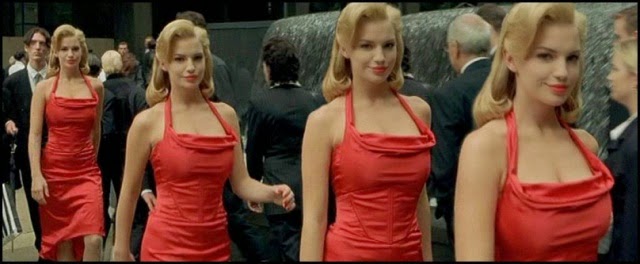
Fiona Johnson, "The Girl In The Red Dress," The Matrix (1999)
supernormal stimulus
Nikolaas "Niko" Tinbergen (1907 - 1988) was a Dutch biologist and is regarded as one of the founders of ethology, the study of animal behavior. His findings, much of which is reported in his seminal writing, “The Study of Instinct” (1951), would earn for him a Nobel Prize (1973).
Among the many animal-behavior discoveries, Tinbergen, along with fellow researcher, Konrad Lorenz, learned that the color red often plays an important part in the mating process.
A particular focus of Tinbergen’s study centered upon what he called the “supernormal stimulus.” This precept would manifest in the construction of an artificial object imbued with a stronger stimulus for an instinct than one supplied by nature. This will become clear when we consider the following interesting examples:

stickleback sees red
The red-underbellied male stickleback, in its territorial protestations, will normally attack other sticklebacks when it sees their red. However, Tinbergen made cardboard versions of the fish, but without great attention to detail, except for the red underside which was painted with more red than found in the real fish. The territorial males mounted a more vigorous attack upon the cardboard fish with the “supernormal stimulus” -- or even against a lump of wax with a red stripe! -- than against the real stickleback intruders.
Editor's note: Tinbergen gained an initial clue as to the secret motivations of the stickleback when a randomly-passing red postal truck caught the attention of the fish in the aquarium, producing an attack-posture!

robin red-breast
A male English robin, in autonomic, stereotypical behavior, will ward off fellow males who venture into his territory. (As I commented to a friend, this is de rigueur on "Animal Planet.") Tinbergen put this stimulus-response to the test by constructing two models: one was simply a tuft of feathers with a bright red stripe (on the left), with the other, a well-crafted and detailed robin but with no red breast (right). The territorial males ferociously attacked the nameless red tuft but gave a pass to the smart-looking mannequin robin.
paper-butterfly dreams
A similar example, Tinbergen made paper butterflies but with exaggerated, more-defined sexual markings. The male butterflies chose the “super-stimulus” paper dreams, moreover, tried to mate with them, while the real-deal butterfly ladies were left idling on the bleachers without a dance partner.
Tinbergen outlines many other examples of programmed animal behavior in his work “The Study of Instinct.”

Let’s look at this carefully, this seminal work on animal behavior by Tinbergen.
If these animals under review could speak to us, they would say, “The color red is the most beautiful color to me. I’m just wild about it, can’t tell you why exactly, but it just makes me feel crazy good. When I see red, I just want it. I desire it so much. It’s all I can think about. It just seems so right and true to me.”
The animals’ perception of beauty as focused upon the color red reveals an underlying biological mechanism. The animals didn’t rationally decide that red is most beautiful of all colors; instead, this view is imposed upon them, and they are helpless but to follow its directive.
On this lowest bio-animal level, we see that a “judgment” of beauty, here, in terms of the color red, reflects a “shining through” of an underlying constitution.
And the question for us becomes, how many perceptions of beauty in our lives are nothing more than an autonomic “super-stimulus” response?
There’s nothing wrong with a stickleback or a robin led by pleasant beauteous visions of red; and, as we are bio-mammals, there's nothing wrong with this principle as pertaining to our particular situation; but, let’s not confuse ourselves to believe that “seeing red,” in terms of species perpetuation, is anything more than instinctual impulse. It's very much a programmed bio-perception of "beauty."
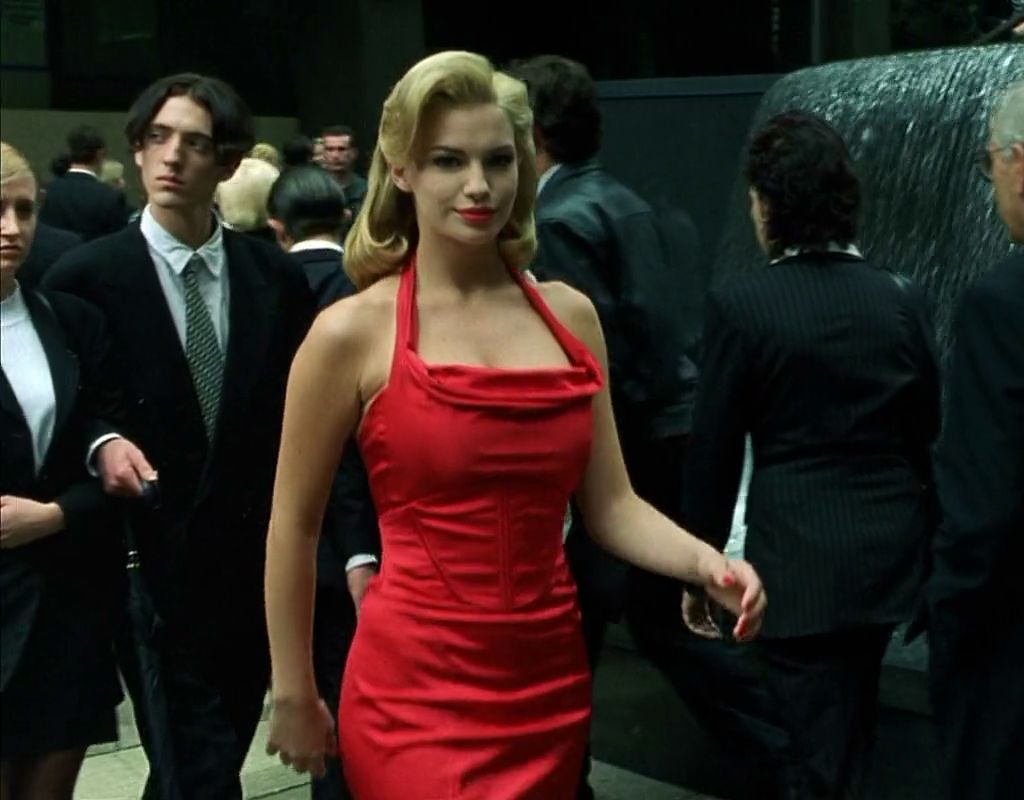
|
in the unenlightened state, what we consider to be beautiful is just a product, a reflection, of biological constitution, super-stimulus riot, and tribal inculcation
We were taught to like what we like, grandma said it was good, and now we think it’s the only way in the world. We say “This is our truth, this is what we desire, this is what is good, this is what is beautiful.”
But the sticklebacks and the robins would say the same thing. Should we be so impressed?
|
the Nice Young Man at Church has no power to transform mere mammalian super-stimulus fever into a real marriage of spirits
Even the Pope said this; that, marriages thus constituted are “religiously null.” But John and Mary, even the conscientious and well-meaning ones, already know this; and the emptiness of heart and soul speak most loudly during sleepless nights at 3 AM. What's required is a "union of spirits."
You cannot change, you cannot transform -- via hocus-pocus, some magic hand-sign and empty godtalk -- common biological contagion into a true marriage of two souls in union.

None of the “religiously null” marriages of this world will survive transition to the next, nor shall they enjoy legal standing in the “courts of heaven.” At best, it's just a temporary "domestic business contract," which might easily be voided.
Unless your mate is linked to you at the soul level, it’s all just “playing house” and “playing church.”
|
so much could be said here; books and libraries could be filled with relevant thoughts
But we must close this discussion.
However, let us fast-forward beyond all the tribal inculcations, the maternal creedalisms, the mammalian pre-programings, which determine private and narrow definitions of Truth, Goodness, and Beauty. I think we can see the problem now for all those who still lack “eyes in their head” and have not yet discovered “the true self”; those who are confused about “real versus apparent goods” and do not yet perceive that which they “ought” to desire.
Editor's note: What an interesting concept – what we “ought” to desire! And what ought we to do desire? We ought to desire the real goods which conform to Ultimate Reality, our eternal lives in Summerland, our "made in the image" spiritual constitution, our destiny to emulate Mother-Father God.
Again, much could be said here. But let us focus on that major topic of the Word Gems site – eternal, romantic Twin-Soul love.
When you finally find her or realize who she is, you will say that she is beautiful. But when you do, it will not be the kind of statement made by a stickleback or a robin. Our animal friends tend to believe in the “many fish in the sea” doctrine: if you miss out on one, there are always ten other “beautiful” faces to meet. “Beautiful” in this context means “My attraction to you is biologically based, an impulse fueled by instinct, and if it’s not satisfied in you, then I’ll find another pretty face very soon.”
'no one there to fill your desire': the hollow chocolate rabbit
It is not, nor shall it ever be, in this life or the next, possible to “fill your desire” with the insubstantiality, the “hollow chocolate rabbit,” of Niko Tinbergen’s super-stimulus. While we share much commonality with our fur-and-feather brethren, we are also much more; we harbor a spiritual, “made in the image” component which demands that our love relationships reflect a deep affinity. Nothing else will satisfy.
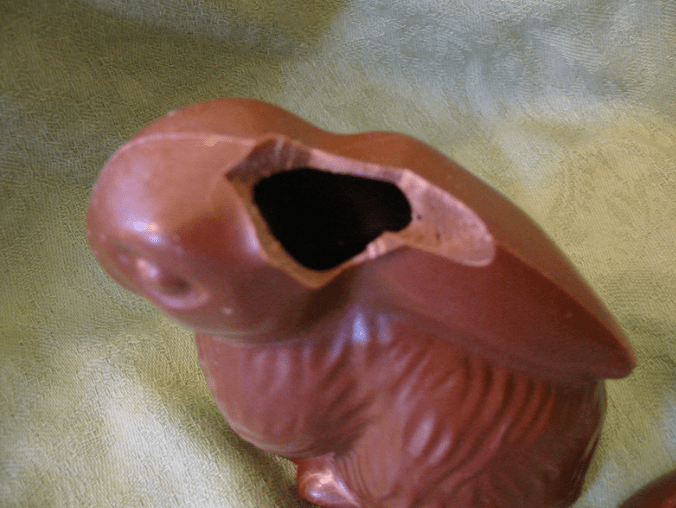
oh, the disappointment of a hollow chocolate rabbit
But such calamity does not exist with the Sacred Beloved. Each for the other, there is but one, a particular one, with no substitute allowed or able, to "fill your desire."
Editor's note: What a great song lyric: "no one there to fill your desire." And now we know that this concept of filling one's desire includes the ultimate good, an unyielding truth, and the supremely beautiful.
the great shining through
And when you find her, Plotinus’ great insight will become enfleshed and take life to itself:
"Beauty is the translucence, through material phenomena, of the eternal splendor of the One.”
You will say that she is beautiful. But this statement, while not excluding what the robins mean, primarily signifies your utter astonishment, a concussion of wonderment, a flooding marvel, that she represents a “translucence,” a shining through, of all that God has destined for you, with her -- to do, to experience, and to become.
Contrary to long-held despair, the deeply entrenched disheartenment, there is, after all, a particular one to fill your desire – and, even more – she will also fill, fill to the top, your sense of the Good, the True, and the Beautiful.
|
beauty is not in the thing
Jiddu Krishnamurti, September 24, 1967, London: “Like love, beauty is not the cultivation of thought. A thing of beauty is not beauty. Beauty is not in the thing, in the building, in the person; but there is that beauty which is not the result of conditioning, in which thought in no way interferes.”
The sense of beauty is an opinion, a judgment, concerning the good and the true.
Beauty issues not from one's “hardware” but “software,” the “programming.”

See more discussion in the “waves” article.
|
|











